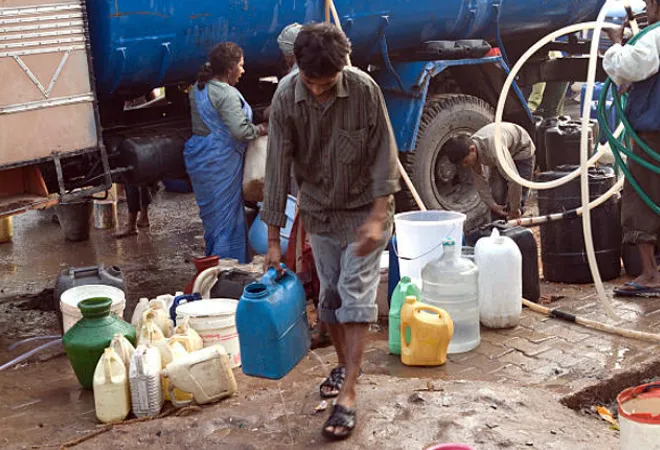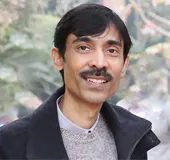-
CENTRES
Progammes & Centres
Location
A review of the water challenges in Delhi and the draft master plan for the city’s water supply and needs
 In Delhi, many people do not have access to piped drinking water, and there are spatial inequalities in supply. This article reviews the policy proposals of the draft master plan for Delhi to improve its water sector. It is concluded that the water supply agency must demonstrate a higher level of efficiency for effective implementation of the proposals.
The water supply agency in Delhi collects about 935 million gallons per day (mgd) of raw water from various sources—river, canal, underground, rain, etc. Due to less water availability in Delhi, almost 50 percent of the water is obtained from surface sources located in the neighbouring states of Haryana, Himachal Pradesh, and Uttar Pradesh.
The city’s demand for water for a population of 19 million is, however, more (i.e. 1,140 mgd), which means a shortage in supply of about 200 mgd. Thus, about 18 percent of the demand is not being met. The demand is calculated on the basis of daily water need of each person living in Delhi, i.e., 19 million persons in the year 2020 multiplied by 60 gallons per capita daily (gpcd).
In Delhi, many people do not have access to piped drinking water, and there are spatial inequalities in supply. This article reviews the policy proposals of the draft master plan for Delhi to improve its water sector. It is concluded that the water supply agency must demonstrate a higher level of efficiency for effective implementation of the proposals.
The water supply agency in Delhi collects about 935 million gallons per day (mgd) of raw water from various sources—river, canal, underground, rain, etc. Due to less water availability in Delhi, almost 50 percent of the water is obtained from surface sources located in the neighbouring states of Haryana, Himachal Pradesh, and Uttar Pradesh.
The city’s demand for water for a population of 19 million is, however, more (i.e. 1,140 mgd), which means a shortage in supply of about 200 mgd. Thus, about 18 percent of the demand is not being met. The demand is calculated on the basis of daily water need of each person living in Delhi, i.e., 19 million persons in the year 2020 multiplied by 60 gallons per capita daily (gpcd).
Due to less water availability in Delhi, almost 50 percent of the water is obtained from surface sources located in the neighbouring states of Haryana, Himachal Pradesh, and Uttar Pradesh.It is estimated that the demand for water in Delhi will grow to 1,746 mgd by 2031, and efforts will be made to bring this down to 1,455 mgd for a projected population of 29 million by 2041. Delhi is experiencing a decline in population growth rate, and urban centres in adjoining states are registering higher growth. The adverse impact of the existing water shortage is noticeable in Delhi. Except for one or two pilot projects, none of the planned areas receive piped water supply on a 24-hour basis. The current pattern of piped supply to consumers living in various parts of Delhi differs. According to the water supply timing schedule of the Delhi Jal Board, households of economically weaker sections (EWS) situated in Pocket-C, Sector-3, Dwarka (Dwarka is a sub-city in south west Delhi) receive water from 5:45 am to 6:15 am and then from 5:45 pm to 6:15 pm. Thus, about an hour’s supply is received in a day. Amongst posh colonies, West End receives 24-hour water supply under a public-private partnership (PPP) project, whereas Vasant Vihar, Shanti Niketan, and Anand Niketan (residential areas in south Delhi) receive up to 4 hours of supply daily. Most consumers receiving piped supply follow the practice of storing water in overhead tanks on a daily basis. This makes it convenient for them to utilise water when required. Delhi is also home to a large number of people living in informal areas, i.e., slums and unauthorised colonies. While the water agency supplies water to households in these areas through tankers and pipeline, irregularities are noted in this regard.
Most consumers receiving piped supply follow the practice of storing water in overhead tanks on a daily basis. This makes it convenient for them to utilise water when required.Non (or less) availability of water creates hardship, particularly in the lives and livelihood of communities living in informal areas. Occasionally, there are incidents of protests and conflicts over water. Data shows that 17 percent of households in Delhi do not have access to piped water, and 13 percent of unauthorised colonies are yet to be covered by piped water supply. The above-mentioned information and statistics help in understanding problems concerning Delhi’s water supply, particularly related to inadequate supply and inequitable distribution. The problem has arisen due to the following reasons:
The treated wastewater will be used for non-potable purposes, such as horticulture, irrigation, road cleaning, industry, fire fighting, and construction.Steps will be taken to treat and reuse 100 percent wastewater for which decentralised wastewater treatment plants with dual piping will be installed in newly developing areas. The treated wastewater will be used for non-potable purposes, such as horticulture, irrigation, road cleaning, industry, fire fighting, and construction. Existing government and commercial buildings would also be required to shift to decentralised systems and dual piping. Another water conservation method proposed for new developments, regeneration projects, and existing government/commercial buildings is the installation of low water consumption plumbing fixtures. Priority has also been given to development of systems and facilities for rainwater harvesting and capturing of storm water runoff. For this purpose, parks and open spaces will be created in low lying areas, and water sensitive urban design principles will be applied, such as pervious (permeable) storm water drains, semi-pervious pavements and public parking areas, rain gardens, etc. These measures are aimed at ensuring groundwater recharge, as well as storage for non-potable uses. Lastly, the draft master plan calls for addressing deficiencies in the existing system of water supply. These relate to reduction of non-revenue water, 100 percent metering of connections, introduction of telescopic water pricing, and better maintenance of sewerage network.
The draft master plan calls for addressing deficiencies in the existing system of water supply.The draft plan proposals for improvement of water sector in Delhi would be useful in addressing issues of shortage, inequity, and wastage. However, these will have to be applied effectively. The past performance of the water agency in implementing similar measures has been encouraging on a number of fronts. A higher level of efficiency needs to be demonstrated if the goal of water for all is to be achieved. Working condition of functionaries and their capabilities, financial condition and accountability of water agency, maintenance of water/sewer networks and infrastructure, participation of non-government stakeholders, water conservation awareness among citizens, and violations by consumers remain matters of concern. Delhi’s water is consumed by a large regional population, as many workers come to the city every day. The adjoining state governments should consider this dimension and accordingly develop a suitable water-sharing formula.
The views expressed above belong to the author(s). ORF research and analyses now available on Telegram! Click here to access our curated content — blogs, longforms and interviews.

Rumi Aijaz is Senior Fellow at ORF where he is responsible for the conduct of the Urban Policy Research Initiative. He conceived and designed the ...
Read More +